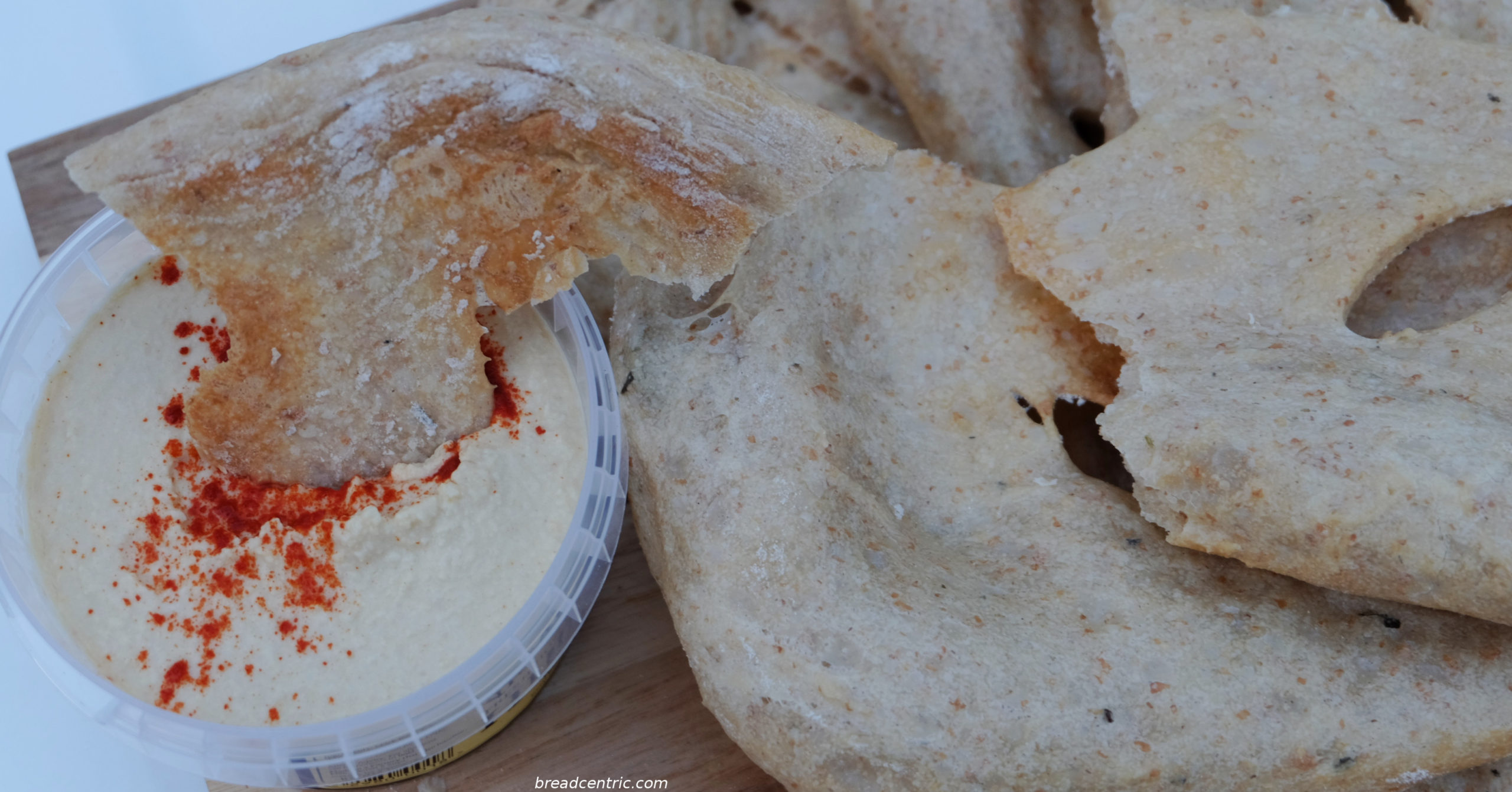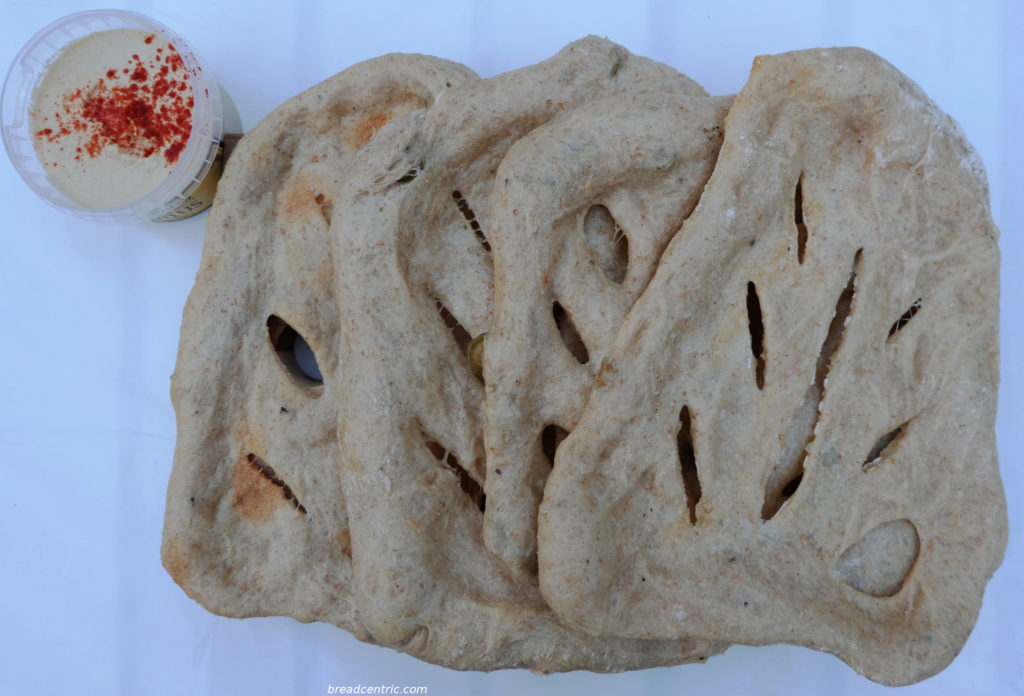Today we’re still in the snacks department. Let me introduce a bread with fancy looks, not too good for a sandwich but perfect to pull apart and dip in something before eating.
Dziś pozostajemy w dziale przekąsek. Z przyjemnością zaprezentuję Wam chleb o nietypowym wyglądzie, nienajlepszy na kanapkę, ale idealny żeby go porwać i zanurzyć w czymś przed jedzeniem.
It’s so hot today, I don’t really feel like making anything, so I’m focusing on snacks now, something reasonably easy to make and with a nice effect.
Fougasse is a French bread, most often flat and with holes. I’ve made it once before and it was delicious. It was so long before that the only thing I remember about it is that I still traces after burning my hands then. I think it was one of the first times when I baked at temperatures around 230 C degrees.

This time I decided to add olives as the recipe suggested. I went to a Cypriot supermarket called Yasar Halim. When I enter a Polish store it’s like going home. When I visit a Cypriot store it’s like a distant travel adventure. We’ve got two stores like that close to home (the other run by Andreas Michli with family) and they differ a bit, but I enjoy visiting both. This time I went to Yasar Halim to get the olives and hummus for dipping.

Before we continue, just a note: This recipe comes from “Bread” by J. Hamelman (sources), but you don’t need to use this dough. You can use your favourite pizza dough recipe, or any other that you know how to make. You may need to work out proofing times for it.
The recipe mentions dough proofing temperatures around 24 C degrees, and it’s above 30 C degrees today, so I used a bit less yeast and shortened times.
Planning
This recipe uses a levain prepared around 12 hours before making the dough, then 2 hours proofing, dividing, 1 hour proofing, stretching and baking.
Because it was hot, I did 8 hours for levain, 90 minutes bulk proof and around an hour final proofing (would’ve done less, but the oven was occupied and we made a small barber shop at home in the meantime.
Ingredients
Mister Hamelman says it’s for two fougasses, I made four smaller ones, around 230 g each.
Levain
- 122 g strong white wheat flour
- 79 g water
- 2 g salt
- pinch of dried yeast (or 0.2 g fresh yeast)
Final dough
Just note that the levain, olives and olive oil are added later then the rest.
- 320 g strong white wheat flour
- 48 g wholemeal wheat flour
- 255 g water
- 6 g salt
- 3 g instant yeast or 8 g fresh
- 26 g olive oil
- 40 g olives, sliced (you can skip them or replace with anchovies)
- 204 g levain
Preparation
- Mix the levain and leave for about 12 hours
- Mix all the dough ingredients except for olive oil, olives and levain and 10% of water (meaning add only 90%). Use low speed for about 3 minutes. Gradually add chunks of the levain. Add the rest of the water if you think the dough is too dry
- Switch to higher speed for the next 6 minutes. Gradually add the olive oil. This part improves the gluten structure
- Stop the mixer, make a well in the middle and put a third of the olives in and turn it on for about 30 seconds. Stop, make well, add half of the remaining olives, mix for 30 seconds. Stop, make well, add the rest, mix for 30 seconds. This is a trick to add olives late enough to not have them broken and mashed into the dough, have them spread evenly and not have them stuck to the walls of the mixer bowl
- Leave the dough for 2 hours. Stretch and fold after 1 hour
- Split the dough in portions, I did four. Round each portion, place on floured surface, cover with cling film
- Leave for an hour. If you’re baking on a stone, start the oven straight away
- Start the oven, set it to 230 C degrees. I used a fan, as I think it doesn’t make much difference with this bake. Know your oven
- I placed the dough on floured baking trays and didn’t use a stone. I placed one on a baking parchment, worked well too
- Stretch the chunk into a triangle-like shape, cut the holes in it for decoration, then stretch a little bit more to open the holes. If you want a stronger flavour, you can brush it with olive oil and sprinkle some salt or pepper on it
- Bake for about 20 minutes with steam in the oven. After about 10 minutes release the steam
- They cool down very quickly, so you should not have to wait too long. I recommend having some dip for it, at least some olive oil
I didn’t bother shaping them too precisely, so they turned out a bit too thin here and there, but other than that they were ok, crunchy on the outside, soft on the inside. When taking out of the oven I thought I baked them dry and hard, but they softened immediately. I could have left them for a bit to get a darker colour, but I was affraid I would burn them.
The advantage of fougasse is that you can use whichever dough you like and even when shaped in an average way, they still look nice. I recommend preparing them right before eating, as there is a lot of area to get hard quickly.
Dziś jest tak gorąco, że nie mam zbytnio ochoty na robienie czegokolwiek, więc skupiłem się na przekąskach, czymś względnie łatwym do zrobienia i z ładnym efektem końcowym.
Fougasse to francuski chleb, zazwyczaj płaski i z dziurami. Zrobiłem go już raz wcześniej i był pyszny. To było tak dawno temu, że jedyne co pamiętam z tego pieczenia to ślady poparzeń na dłoniach. To chyba był jeden z pierwszych razów, kiedy piekłem w tak wysokich temperaturach (około 230 stopni).

Tym razem postanowiłem dodać do ciasta oliwki, tak jak sugerował przepis. Poszedłem do cypryjskiego supermarketu Yasar Halim. Kiedy wchodzę do polskiego sklepu, czuję się jakbym wrócił do domu. Kiedy odwiedzam sklep cypryjski, jest to dla mnie jak przygoda w dalekiej podróży. Mamy dwa takie sklepy blisko domu (drugi jest prowadzony przez Andreasa Michli, postać-ikonę w tym rejonie Tottenhamu, z rodziną). Różnią się one nieco od siebie, ale lubię odwiedzać oba. Tym razem poszedłem do Yasar Halim po oliwki i humus jako dip.

Zanim będziemy kontynuować, mała uwaga: przepis pochodzi z książki “Chleb” J. Hamelmana(źródła), ale nie musisz używać tego ciasta. Możesz użyć przepisu na swoje ulubione ciasto pizzowe, lub jakiekolwiek inne chlebowe, które wiesz jak zrobić. Pewnie będziesz musieć wypracować sobie czasy wyrastania.
Przepis sugeruje wyrastanie w temperaturach ciasta około 24 stopni, ale tu teraz na dworze jest ponad 30 stopni, więc użyłem mniej drożdży i skrócone czasy.
Planowanie
Przepis wykorzystuje zaczyn, zrobiony około 12 godzin przed ciastem, następnie 2 godziny wyrastania, dzielenie, 1 godzina wyrastania, rozciąganie i pieczenie 20 minut.
Ponieważ było gorąco, zaczyn wyrastał 8 godzin, pierwsze wyrastania trwało 90 minut, a drugie około godziny (zrobiłbym mniej, ale piekarnik był zajęty, a my w międzyczasie zrobiliśmy mały zakład fryzjerski w domu).
Składniki
Pan Hamelman mówi, że to na dwa fougasse’y. Ja zrobiłem cztery mniejsze, około 230 g każdy.
Zaczyn
- 122 g mąki pszennej chlebowej
- 79 g wody
- 2 g soli
- szczypta suszonych drożdży (lub 0,2 g świeżych)
Końcowe ciasto
Weź pod uwagę, że zaczyn, oliwki i oliwa z oliwek są dodawane później.
- 320 g mąki pszennej chlebowej
- 48 g mąki pszennej razowej
- 255 g wody
- 6 g soli
- 3 g drożdży instant lub 8 g świeżych
- 26 g oliwy z oliwek
- 40 g oliwek, pokrojonych (możesz je zastąpić achois, lub całkiem pominąć)
- 204 g zaczynu
Przygotowanie
- Zamieszaj zaczyn i pozostaw na około 12 godzin
- Połącz wszystkie składniki na ciasto poza oliwą, oliwkami, zaczynem i około 10% wody (czyli dodaj tylko 90%). Użyj niskiej prędkości, około 3 minut. Stopniowo dodaj kawałki zaczynu. Dodaj resztę wody, jeśli wydaje Ci się, że ciasto jest zbyt suche
- Przełącz na wyższą prędkość na 6 minut. Stopniowo dodawaj oliwę z oliwek. Ten etap rozwija siatkę glutenową
- Zatrzymaj mikser, wykonaj dziurkę w środku i włóż do niej jedną trzecią oliwek , następnie uruchom mikser na 30 sekund. Zatrzymaj, zrób dziurkę, wrzuć połowę pozostałych oliwek, mieszaj 30 sekund. Zatrzymaj, zrób dziurkę, wrzuć resztę oliwek, mieszaj przez 30 sekund. To jest sztuczka, aby nie rozsmarować oliwek w cieście, ani nie skończyć z oliwkami oblepiającymi ścianki miski
- Pozostaw ciasto na 2 godziny. Rozciągnij i złóż po godzinie
- Podziel ciasto na porcje, ja zrobiłem cztery. Zaokrąglij każdą porcję, połóż na oprószonej mąką powierzchni i przykryj folią kuchenną
- Pozostaw na godzinę. Jeśli masz kamień do pieczenia, włącz od razu piekarnik
- Uruchom piekarnik na 230 stopni. Ja użyłem termoobiegu, bo mam wrażenie, że nie ma to zbytniego znaczenia przy pieczeniu 20 minut. Znaj swój piekarnik
- Umieściłem ciasto na oprószonych mąką tackach do pieczenia i na papierze do pieczenia. Nie użyłem kamienia. W jednym przypadku użyłem papieru do pieczenia jako podkładkę i rezultat był ok
- Rozciągnij kęs ciasta na kształt trójkątopodobny, wytnij otwory dla dekoracji i rozciągnij jeszcze trochę, aby otworzyć otwory. Jeśli chcesz mocniejszy smak, posmarujcie sobie fougasse’y przed pieczeniem oliwą i posyp solą lub pieprzem
- Piecz przez około 20 minut z parą w piekarniku. Po około 10 minutach wypuść parę
- Szybko stygną, więc nie musisz długo na nie czekać. Polecam jakiś dip/sos do nich, chociaż oliwę z oliwek
Nie dbałem zbytnio o precyzyjny kształt, więc wyszły trochę za cienkie w kilku miejscach, ale mimo to były ok, chrupiące na zewnątrz i miękkie w środku. Kiedy wyjmowałem je z piekarnika, myślałem że spiekłem je na wiór, ale zmiękły zaraz po wyjęciu. Mogłem je mocniej zrumienić, ale bałem się że właśnie spalę.
Zaletą fougasse jest to, że możesz użyć jakiego tylko ciasta chcesz i nawet uformowane na odwal wyglądają ładnie. Polecam przygotować je tuż przed jedzeniem, bo mają dużą powierzchnię do wyschnięcia.

